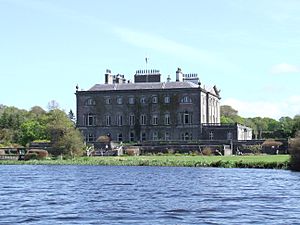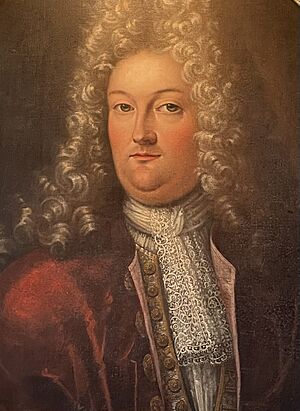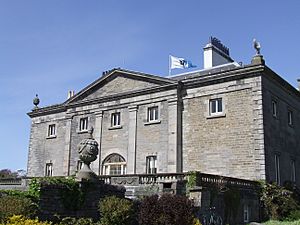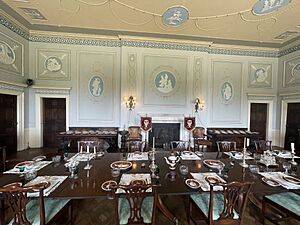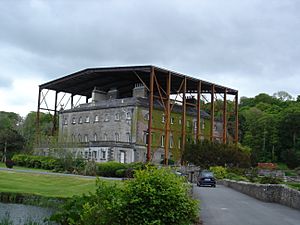Westport House facts for kids
Quick facts for kids Westport House |
|
|---|---|
|
Teach Chathair na Mart
|
|
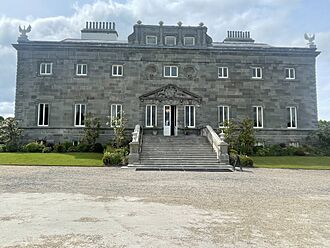
Westport House East Front in 2023
|
|
| General information | |
| Status | Private dwelling house / campsite |
| Type | House |
| Architectural style | Palladian Georgian |
| Town or city | Westport, County Mayo |
| Country | Ireland |
| Coordinates | 53°48′03″N 9°32′11″W / 53.800785°N 9.5363634°W |
| Estimated completion | 1731 |
| Owner | Hughes family |
| Technical details | |
| Material | limestone |
| Floor count | 3 over basement |
| Design and construction | |
| Architect |
|
| Developer | John Browne, 1st Earl of Altamont |
Westport House is a beautiful country house located in Westport, County Mayo, Ireland. It is a Georgian style building. For a long time, it was the home of the Browne family, who held the noble title of Marquess of Sligo. Famous architects like Richard Cassels, Thomas Ivory, and James Wyatt helped design and add to the house.
In 2014, the house and the noble title became separate. The last Marquess of Sligo, Jeremy Browne, left the house to his five daughters. His cousin, Sebastian Ulick Browne, inherited the title.
In 2017, a local business family, the Hughes family, bought Westport House. They also own a company called Portwest.
Contents
A Look at Westport House History
The very first Westport House was built by Colonel John Browne (1638–1711). It stood on the site of an old castle called Cahernamart, which belonged to the O'Malley family. Colonel Browne married Maud Bourke, who was a descendant of the famous pirate queen, Grace O'Malley.
At that time, the house was right by the sea. The tide would come in and out against its walls. Colonel Browne was a Roman Catholic and fought in a war to support King James.
His grandson, also named John Browne, changed his religion to the Church of Ireland. This helped him and his family become more successful. He later became the First Earl of Altamont.
Building the Modern House
The Browne family rebuilt the house in the 1700s. Richard Cassels designed the new house in a Palladian style. This part of the house is the modern east section that faces the town.
Later, in 1773, Thomas Ivory suggested more additions, but these plans were not fully used. The house was made bigger around 1778, likely following other plans by Ivory.
James Wyatt redesigned one of the dining rooms in 1781. He also designed a greenhouse for John Browne, the 3rd Earl of Altamont, in 1796.
In 1808, Henry Holland designed a gate at the northeast end of the town. This gate was taken down around 1958.
In 1819, a South wing was added, designed by Benjamin Wyatt. This wing had a library. Sadly, it burned down in 1826 because of a problem with the heating system. It was rebuilt after the fire.
After the fire, the Second Marquess of Sligo created a new library. He also had the drawing room rebuilt. The ceiling was painted to look like the sky. He bought many landscape paintings by James Arthur O'Connor.
In 1858, George Wilkinson designed a grand staircase made of beautiful Sicilian marble. This staircase replaced the library of the Second Marquess. Italian workers built it. The fancy railing had the Browne family's eagle symbol.
A special farm was built on the estate in the early 1800s. It had places for animals and their food. You can still see the remains of an old boathouse by the sea.
Westport House in the 2000s
In 2007, the estate received a grant of over €1.3 million from the Heritage Council to help with repairs.
After the death of the 11th Marquess of Sligo in July 2014, his five daughters inherited the house. This was possible because of a special law passed in 1993.
In October 2015, it was shared that the Westport House Estate had debts of almost €10 million. These debts were connected to the estate's land, but not the house itself.
On January 17, 2017, the daughters of the 11th Marquess sold Westport House to the Hughes family. This ended the Browne family's ownership of the house after hundreds of years. The Hughes family planned to spend €50 million to improve the house and grounds.
House Design and Art
The east front of Westport House was built around 1730. It was designed by Richard Cassels for John Browne, the 1st Earl of Altamont. The house is made from limestone taken from a nearby quarry.
The doors inside are made of mahogany wood. This wood came from the family's estates in Jamaica. You can still see some original drawings by James Wyatt and his son, Benjamin Wyatt, in the house. Benjamin Wyatt built the wings on the north and south sides of the house.
The grand staircase and the covering of the open courtyard in the middle of the house were added later. The last part of the house's development was creating the terraces on the west side.
Inside the House: Art and Treasures
Westport House still has most of its original items from the Browne family.
- Paintings: You can see portraits by famous artists like Sir Joshua Reynolds. These include paintings of the 1st Earl of Altamont and other family members. There's also a portrait by William Beechey of Howe Peter, the 2nd Marquess of Sligo. He was a friend of King George IV and the poet Byron. Another painting is of Earl Howe, the father of the 1st Marchioness of Sligo, by John Singleton Copley. The house also has many landscape paintings of the local area by James Arthur O'Connor.
- Sculpture: On the marble staircase, there is a marble statue called the Angel of Welcome. It was bought in Rome in 1862. The flame on its forehead represents the Holy Spirit.
- Other Treasures: Westport House has a beautiful collection of old English and Irish silver. This includes 18th-century Irish "potato" rings. There is also Waterford glass and a library filled with old Irish books. You can also see the Mayo Legion Flag, which was brought to Ireland by General Humbert in 1798. General Humbert's troops even stayed in Westport House for a time.
The Browne Family Story
The Browne family owned Westport House for almost 300 years, until January 17, 2017.
The Browne family came to County Mayo from England in the 1500s. They built up their land by marrying into Irish families and buying property. Because they were a Catholic family, their lands in Connacht were safe from land seizures by Cromwell.
John Browne III (1638–1711) was a successful lawyer. He became the owner of Westport after marrying Maud Bourke in 1669. She was a great-great-granddaughter of the famous 'Pirate Queen', Grace O'Malley. John Browne greatly increased his land in Mayo and Galway.
However, the family faced hard times during the Williamite Wars. John Browne supported the Jacobite side. He even supplied cannonballs and weapons from his iron mines near Westport. When his side lost the war in 1691, the family lost much of their wealth. By the time he died in 1711, his estate was much smaller.
The Penal Laws made it difficult for Catholics. So, his grandson, John IV, decided to change his religion. This helped the family survive and avoid losing more land.
John IV slowly brought the family's wealth back. He was young and ambitious. He expanded his estate and turned the old O'Malley castle into the modern Westport House. He also created the new town of Westport, where he started a successful linen industry. In 1771, he became the 1st Earl of Altamont. In 1752, his son, Peter, 2nd Earl of Altamont, married Elizabeth Kelly. Her family's estates in Jamaica added even more wealth to the Browne family.
John, the 3rd Earl of Altamont, continued his grandfather's work. He created the lake west of Westport House and planted many trees. He also hired James Wyatt to decorate parts of the house. He planned the main streets of Westport, and many streets today are named after Browne family members. He also helped build the town of Louisburgh. In 1787, he married Louisa Catherine. He became the 1st Marquess of Sligo in 1800.
His only son, Howe Browne, 2nd Marquess of Sligo, inherited the title in 1809 when he was 21. He was known for being generous and adventurous. He traveled a lot in Europe. He even explored ancient ruins in Greece. He got into trouble and spent time in jail for trying to bring ancient treasures from Greece to Westport in a way that wasn't allowed during wartime. He was a friend of King George IV and the poet Byron. He married Lady Hester de Burgh and had 14 children. He then settled down at Westport.
The 2nd Lord Sligo added the north and south wings to the house. He also added the library and bought many pieces of furniture, china, silver, and paintings. He bred racehorses. He also owned the last two Irish wolfhounds. In 1834, he became the Governor of Jamaica. He worked to end the system where formerly enslaved people had to work for a period after slavery was abolished. He faced a lot of opposition from plantation owners. He was the first to free the enslaved people on his family's Jamaican plantations. The first "free village" in the world, Sligoville, was named after him. He was one of the few Irish nobles who voted for Catholic Emancipation. He died in 1845, just as the Great Famine began in Mayo.
His son, George, 3rd Marquess of Sligo, inherited the estate during the terrible Great Famine. The west of Ireland was hit hardest. Westport House was closed, and with no rent coming in, the 3rd Lord Sligo borrowed money. He spent £50,000 of his own money to help his tenants. He brought in food to Westport Quay and supported the local workhouse, which was the only shelter for those in need. He wrote to the British Government, asking them to do more to help. He also wrote a pamphlet suggesting ways to improve the economy. In 1854, he was offered an honor, the Order of St Patrick, but he refused it. He was disappointed with Britain's policies towards Ireland.
Lord John Browne became the 4th Marquess of Sligo in 1896. He was a skilled farmer. He managed to make the estate profitable again through agriculture. He also had repairs done to the house and gardens.
Henry Ulick Browne, 5th Marquess of Sligo (1831–1913) was another brother. He had retired from his career in India and lived at Westport House with his wife.
George Browne, 6th Marquess of Sligo became the 6th Marquess in 1913. He was very active. He rebuilt the stable block and created the terraces above the lake. He installed central heating, electric lights, and six bathrooms. He made sure the house was in good condition. He also added a sawmill and planted many trees.
Ulick de Burgh Browne, 7th Marquess of Sligo inherited the house in great condition in 1935. He died at Westport in 1941. His mother, the Sixth Marchioness, lived in Westport during World War II.
Arthur Howe Browne became the 8th Marquess in 1941. He had been in the British Army. In his time, some of the town lawns were taken for public housing. This changed the historical connection between the house and the town. His brother, Terence, 9th Marquess, succeeded him but died a year later.
Denis, 10th Marquess of Sligo, became the 10th Marquess in 1953. He and his wife, Jose Gauche, found that the farmlands were not making money. They decided to open the house to the public. This was one of the first houses in Ireland to try this. Jose Browne worked hard to clear out old items and decorate the rooms. She was an artist and designed fabrics for the house. She is known for being the house's "chatelaine" and interior designer. The 11th Marquess then took over the business. He died in 2014.
The Browne family sadly put Westport House up for sale in 2016. They sold it to the Hughes family on January 17, 2017. This ended the Browne family's long connection with Westport House. The Hughes family promised to improve the facilities and expand the estate.
Browne Family and Jamaica
Some members of the Browne family historically owned plantations in Jamaica where enslaved people worked. Howe Browne, 2nd Marquess of Sligo, and his wife, Lady Sligo, were among them. The 2nd Marquess served as the Governor of Jamaica from 1834 to 1836.
An exhibition at Westport House calls the 2nd Marquess of Sligo a 'Champion of the Slaves'. While he did work to end slavery later in his life, he also benefited from the system for many years. He was the first to free the enslaved people on his family's Jamaican plantations. The village of Sligoville in Jamaica is still named after him today.
The family's plantations in Jamaica, called 'Kellys pen' and 'Cocoa Walk', and the enslaved workers, came into the Browne family in 1752. This happened when Peter Browne married Elizabeth Kelly, whose father was a judge in Jamaica.
Music and Events
Westport House has hosted several music festivals.
- In June 2012, the first Westport Festival of Music and Performing Arts took place. Artists like Jools Holland, The Waterboys, and Imelda May performed.
- In August 2017, Aiken Promotions used Westport House as a venue for the first Harvest Country Music Festival. Headliners included Miranda Lambert and Nathan Carter.
See also
- Hazelwood House, Sligo


